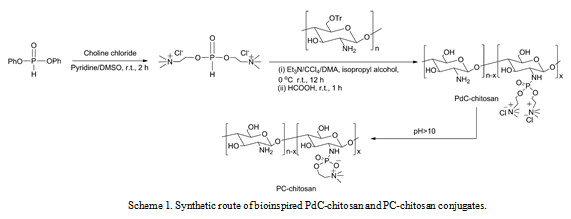Introduction: Infections caused by pathogenic bacteria are a serious threat to human health, efficient and safe antibacterial agents are therefore in great demand[1],[2]. Antimicrobial polymers mimicking naturally occurring host-defense peptides have attracted a significant research interest[3],[4]. Most of them are cationic and amphiphilic polymers, however, poor biocompatibility and non-biodegradability limit their applications. To overcome these limitation, herein we report the synthesis of a novel bioinspired cationically charged phosphodicholine (PdC) coupled chitosan and explore its interactions with bacteria and mammalian cell, compared to zwitterionic phosphorylcholine (PC) chitosan conjugate[5]. The results demonstrated that biodegradable PdC-chitosan conjugate is an excellent antibacterial agent with high selectivity against bacteria over mammalian cells.
Experimental Section: Materials: Chitosan and diphenyl phosphite was purchased from Sigma-Aldrich. Choline chloride was obtained from Acros. All other reagents were commercially available and of analytical grade..
Methods: Synthesis: PdC-chitosan and PC-chitosan conjugates were synthesized via Atherton Todd reaction as shown in Scheme 1.

Characterization: 1H and 31P NMR spectra were used to determine the chemical structure of samples. The phase transition of water in biomimetic chitosan conjugates with different water content was investigated by DSC heating process[6]. The biocompatibility of double-positively charged PdC-chitosan was demonstrated by cytotoxicity assay, and its antibacterial activities were tested against Gram-positive bacterium S. aureus and Gram-negative bacterium E.coli using the MIC method, in comparison with those of zwitterionic PC-chitosan.
Results and Discussion: As shown in Figure 1, a characteristic exothermic peak ascribed to cold crystallization was found for both PdC-chitosan and PC-chitosan conjugates in some water contents at the range from -20 to -12 oC, but no cold crystallization phenomena was observed for all chitosan-water samples, which indicated that there exists the freezing bound water due to the introduction of bioinspired PdC and PC groups with specific local charge distribution. The results strongly suggested that double-positively charged PdC-chitosan may show comparable excellent biocompatibility as zwitterionic PC-chitosan due to the presence of freezing bound water.


As shown in Table 1, both double positively-charged PdC-chitosan and zwitterionic PC-chitosan were shown to be non-toxic with IC50 value above 2000 μg/mL assessed by MTT assay. More interestingly, PdC-chitosan exhibited significant antibacterial activities against S. aureus and E.coli , while PC-chitosan did not show potent antibacterial activities. Double-positively charged PdC-chitosan showed high selectivity indices (IC50/MIC) greater than 100, implying that PdC-chitosan is highly selective to bacteria over mammalian cells.
Conclusion: We have prepared a biomimetic double-positively charged PdC conjugated chitosan derivative. DSC measurement suggested that PdC-chitosan was biocompatible as zwitterionic PC-chitosan. Antibacterial activity and biocompatibility evaluation showed that PdC-chitosan may be an excellent antibacterial agent for biomedical and healthcare applications.
the National Natural Science Foundation of China; Science and Technology Program of Guangzhou
References:
[1] A. Coates, Y. Hu, R. Bax, C. Page, Nat. Rev. Drug. Discov. 2002, 1, 895.
[2] J. Hasan, R. J. Crawford, E. P. Ivanova, Trends Biotechnol. 2013, 31, 295.
[3] A. Muñoz-Bonilla, M. Fernández-García, Prog. Polym. Sci. 2012, 37, 281.
[4] K. Kuroda, G. A. Caputo, Wires Nanomed. Nanobiotechnol. 2013, 5, 49.
[5] Rong Zeng, Hua Fu, Yufen Zhao, Macromol. Rapid Commun. 2006, 27, 548.
[6] Tanaka, M.; Mochizuki, A.; J. Biomater. Sci. 2010, 21, 1849-1863.